Composting - Recycling the Golf Course
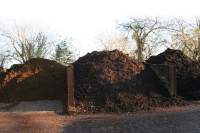
Okay, let's start with the term 'recycled' - put simply, it is something that is secondhand, has been used before or is being reprocessed into something else. Your mower, for instance, has been recycled and was probably once a part of an old car or a metallic object, as were many of your computer components and household appliances. However, these are hard materials and ones that do not really concern us in this industry, so I will concentrate on something a little more biological for now; grass clippings and recycled golf course organic materials to be precise!
Why Compost?
All golf courses and sports grounds create grass clippings and the problem often arises of what to do with them all. Most local councils will remove them for you, as will organic waste companies, but these come with a cost attached, so why not reuse them to your advantage? All that is required to create good quality compost are grass clippings, brown waste (potato peelings and woodchip), shredded paper or cardboard and a spare half an hour a fortnight (a front loading tractor or digger may be required depending on how much reusable material you have).
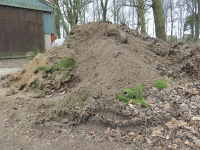
We've all done it, and I suspect that some are still doing it because that's how it's always been done - which is a phrase I personal have grown to dislike.
There are certain circumstances where this behaviour is totally unacceptable and potentially law breaking, such as tipping your grass near, or in, water courses. There are countries (Germany springs to mind) which no longer allow these actions and have placed a total ban on tipping grass onto natural areas. Why, I hear you ask?
I will move onto the science bit a little later on but, if you tip your grass in a pile, the combination of resulting decomposing materials (including salts and organic acids) will scorch any underlying vegetation to a point where it will die off completely, including the roots. This is obviously not a good greenkeeping practice and, if the subsequent decomposing liquid reaches the sub soil, that too will become unsuitable for any further plant growth - the growth which eventually returns is often the so called poorer species of grass, such as annual meadow and yorkshire fog.
You also have to take into account the fact that the clippings could potentially be packed full of fertiliser, fungicide and/or herbicide and could still be active within the clippings you deposit near a pond or stream - therefore, there's lots to think about when disposing of your waste.
The science part:
Compost, what is it? Put simply, it is decaying organic matter which is going to be used as a soil/sand amendment or as an organic fertiliser. However, compost (or composting) is not the part I am talking about today - humus is.
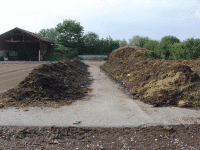
I found out the following astonishing facts during my dissertation research on humus, including realising that it can hold between 80-90% of its own weight in moisture! Not only that, humus releases mild organic acids which dissolve minerals, including zinc and the all-important metallic nutrient, iron, which us grassland managers find so vital to turf performance.
How does humus do this though? Via a process called chelation, which is an in-depth subject in its own right but, for the sake of my word count, I shall keep it brief and indicate that chelati
on acts as a bridge from the previously locked minerals to the grass plant by forming a ring around them, thus freeing up for plant use. As this is scientifically the case, humus therefore affects our grass's health by altering its ability to take up nutrients, which is what we want for our grasses, is it not?
As I mentioned, we are actually looking for the end stage of composting, which is called humus, and humus is the consequence of a four stage process which, not too dissimilar to chelation, is an in-depth study in its own right.
The process is mesophyllic; thermophyllic; stabilisation and maturation, however, I wrote a dissertation on these and it took months of research to scratch the surface of their actions, so I will try and simplify the process in the following words: the initial stage lasts only a few days where the mesophile microbes start to generate heat. This heat triggers the one to six week thermophyllic phase, thus allowing the multiplication of other microbes to further create more warmth.
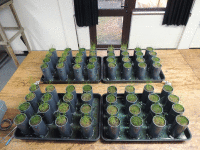
It is imperative that minimum temperatures of 58OC should occur, for at least a day, for sanitation to transpire. At this point, oxygen needs to be made available (by turning the compost) in order for anaerobic decomposition to take a foothold. It is in this stage, however, that temperatures drop, thereby allowing fungal spores to occupy the compost and carrying out enzymic degradation to the subsequent humus - which is exactly what we need!
Also in this final stage, and this is the bit which gets really exciting, macro fauna and microorganisms colonise the pile, further stabilising the humus ready for use on your course or sportsground. Yet you need to understand that the humus cannot be too lively when you use it, as this brings about lots of potential problems, such as pathogen encouragement and root scorch - be warned!
The trials I carried out with compost and recycled sand - on strong creeping red fescue and perennial rye grass grown under controlled conditions - suggested that root weight, grass weight, colour, NDVI readings (Normalised Difference Vegetation Index provides an estimate of the plants growth, vigour, vegetation health, biomass production and a means of monitoring changes in vegetation over a period of time) were far superior to the plants which grew with no compost.
This is glaringly ob
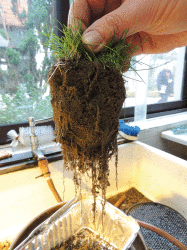
vious to most of us turf managers, but do you know why this happened? It happened because compost has all the attributes toward healthy vegetation, so the message here is add a little compost to your sand and watch what happens.
I'm not, however, suggesting that you build a green, surround or fairway based on compost. I am suggesting that sand, with a small amount of compost added to it, will give you far better results than sand without compost. The requirements for the amount of compost you require is, of course, site and rootzone specific, therefore you would have to carry out your own tests prior to building anything with sand/soil and compost - be sure that humus is stable too please!
How do you make compost/humus?
Simple, actually. However, timing is everything! When you have chosen the concrete area where you will grow your compost (not near a water course or a fine turf area), begin by tipping your grass clippings into a pile and then mix either the woodchip, paper, cardboard or peelings (or all four) together; the reason for adding paper and cardboard into the mix is to allow air gaps to appear when they break down - without lots of oxygen, the pile will not generate enough heat to decompose to its maximum efficiency. The reason we add brown waste is that grass tends not to break down so easily and becomes congealed without a little help from the aforementioned brownies.
If, however, you do not have a suitable concrete base, then a bed of recycled sand may work, depending on how much compost you wish to develop. The sand will catch a good amount of effluent before it reaches the underlying sub/top soil and can be returned to the pile when it is time to move it.
Compost turning can become a tad pungent during the warmer months, so I would try and find an area not too close to the clubhouse or any private properties, or the letters from disgruntled people will flow after you've ruined their washing!
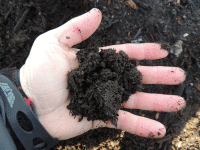
If space is not an issue, then you could try the windrow method. Windrow composting is ideal for the larger venue and one which requires a quick turnaround from organic matter to humus. There are no parameters for the length of lines used in windrowing, but the width needs to be at least two metres for maximum heat generation; any less will cause heat loss, resulting in a slow turnaround.
What do we do with the Compost?
Now the easy part! There's so much you can do with your homemade compost, such as incorporating it into the clubhouse gardens, giving it to the members/public for use as a soil conditioner, mixing it with a growing medium for use under high stress areas, including walkways and the sides of bunkers, or even building winter tees with it.
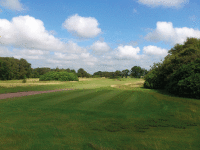
We must remember that sand is a finite resource and one which will eventually become unavailable to the majority of golf courses - that statement was unheard of a few years ago, but I feel that it is fast becoming the reality.
Other areas where a mix of sand/soil and compost has been of use are the walkways to the side of bunkers or the heavily worn areas to the sides of tee banks. I have to point out, again, that a mix of sand/soil and compost are not particularly good for playing surfaces, such as greens and fairways, as it will be a little soft under foot. It is, however, suitable for a winter teeing areas as it offers a small amount of give when the golfers take their shots.
If you fancy something a little different on your golf courses or sports grounds, then why not incorporate a wildflower eco zone using your newly developed humus? That's an article for another day, but I hope you now see that the list is almost limitless where recycling is concerned!
So we have looked at the compost/humus; what it is, how you make it and its uses within a fine turf environment. Who knew we had such a useable and valuable commodity at our disposal which we often just throw away?

He previously worked at Fairhaven Golf Club as their ecology manager and was instrumental in winning many awards and titles for his outstanding knowledge of rural issues and his dedication towards wildlife practices.
He holds an FdSc and a BSc (Hons) in turf science and is a proud recipient of an R&A Gold scholar's badge, which was presented to him at BTME 2014 for outstanding career progression and his work towards the R&A Scholarship.
James has kindly agreed to write a selection of articles based around recycling, flora and fauna, ecology and conservation and, in this issue, James offers us his advice on the use of recycled materials and their subsequent usage on a golf course



